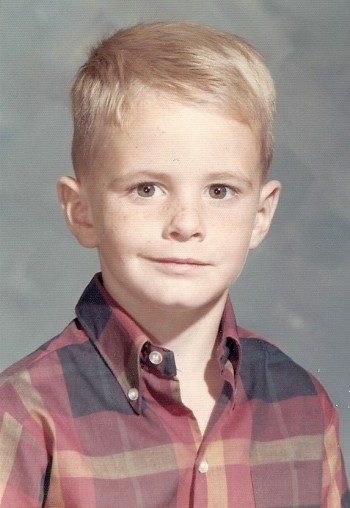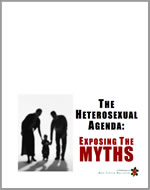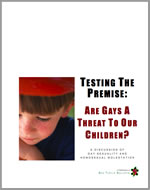Box Turtle Bulletin
 News and commentary about the anti-gay lobby
News and commentary about the anti-gay lobby News and commentary about the anti-gay lobby
News and commentary about the anti-gay lobbyApril 18th, 2011
That’s the conclusion drawn by Columbia University psychologist Mark Hatzenbuehler in a study to be published in an upcoming issue of the journal Pediatrics. I haven’t seen the study myself, but based on news reports and the meager information provided in the study’s abstract, I think caution is in order.
Using data drawn from an Oregon survey, Hatzenbuehler created an social environment index based on (1) the proportion of same-sex couples, (2) the proportion of registered Democrats, (3) the presence of gay-straight alliances in schools, and (4) school policies (nondiscrimination and anti-bullying) that specifically protected lesbian, gay, and bisexual students. Based on that cross-tabulation, he concluded that not only were LGBT students about five times more likely to attempt suicide in the previous twelve months, but that LGBT students were “20% greater in unsupportive environments compared to supportive environments.”
That conclusion passes the gut check, but one can be misled by one’s gut. My first question is this: to what extent does the study control for rural vs. urban environments? That seems like a logical questions, and it immediately leapt to mind in discovering that the data was based on an Oregon survey. Oregon’s urban areas are almost exclusively Democratic while its more rural areas are more uniformly conservative. If this study had taken place in, say, Arizona, where there is a significant mix of urban areas that are wildly conservative (Phoenix, Mesa, Gilbert), and other urban areas which trend Democratic (Tucson, Flagstaff), the result may show something very different. California’s mix of liberal and conservative urban and rural areas would also provide fertile ground to study this further.
Until we know more about this study, I believe caution would be well advised. I hope to obtain a copy of the study soon.
Latest Posts
Featured Reports
 In this original BTB Investigation, we unveil the tragic story of Kirk Murphy, a four-year-old boy who was treated for “cross-gender disturbance” in 1970 by a young grad student by the name of George Rekers. This story is a stark reminder that there are severe and damaging consequences when therapists try to ensure that boys will be boys.
In this original BTB Investigation, we unveil the tragic story of Kirk Murphy, a four-year-old boy who was treated for “cross-gender disturbance” in 1970 by a young grad student by the name of George Rekers. This story is a stark reminder that there are severe and damaging consequences when therapists try to ensure that boys will be boys.
When we first reported on three American anti-gay activists traveling to Kampala for a three-day conference, we had no idea that it would be the first report of a long string of events leading to a proposal to institute the death penalty for LGBT people. But that is exactly what happened. In this report, we review our collection of more than 500 posts to tell the story of one nation’s embrace of hatred toward gay people. This report will be updated continuously as events continue to unfold. Check here for the latest updates.
In 2005, the Southern Poverty Law Center wrote that “[Paul] Cameron’s ‘science’ echoes Nazi Germany.” What the SPLC didn”t know was Cameron doesn’t just “echo” Nazi Germany. He quoted extensively from one of the Final Solution’s architects. This puts his fascination with quarantines, mandatory tattoos, and extermination being a “plausible idea” in a whole new and deeply disturbing light.
On February 10, I attended an all-day “Love Won Out” ex-gay conference in Phoenix, put on by Focus on the Family and Exodus International. In this series of reports, I talk about what I learned there: the people who go to these conferences, the things that they hear, and what this all means for them, their families and for the rest of us.
Prologue: Why I Went To “Love Won Out”
Part 1: What’s Love Got To Do With It?
Part 2: Parents Struggle With “No Exceptions”
Part 3: A Whole New Dialect
Part 4: It Depends On How The Meaning of the Word "Change" Changes
Part 5: A Candid Explanation For "Change"
 At last, the truth can now be told.
At last, the truth can now be told.
Using the same research methods employed by most anti-gay political pressure groups, we examine the statistics and the case studies that dispel many of the myths about heterosexuality. Download your copy today!
And don‘t miss our companion report, How To Write An Anti-Gay Tract In Fifteen Easy Steps.
 Anti-gay activists often charge that gay men and women pose a threat to children. In this report, we explore the supposed connection between homosexuality and child sexual abuse, the conclusions reached by the most knowledgeable professionals in the field, and how anti-gay activists continue to ignore their findings. This has tremendous consequences, not just for gay men and women, but more importantly for the safety of all our children.
Anti-gay activists often charge that gay men and women pose a threat to children. In this report, we explore the supposed connection between homosexuality and child sexual abuse, the conclusions reached by the most knowledgeable professionals in the field, and how anti-gay activists continue to ignore their findings. This has tremendous consequences, not just for gay men and women, but more importantly for the safety of all our children.
Anti-gay activists often cite the “Dutch Study” to claim that gay unions last only about 1½ years and that the these men have an average of eight additional partners per year outside of their steady relationship. In this report, we will take you step by step into the study to see whether the claims are true.
Tony Perkins’ Family Research Council submitted an Amicus Brief to the Maryland Court of Appeals as that court prepared to consider the issue of gay marriage. We examine just one small section of that brief to reveal the junk science and fraudulent claims of the Family “Research” Council.
 The FBI’s annual Hate Crime Statistics aren’t as complete as they ought to be, and their report for 2004 was no exception. In fact, their most recent report has quite a few glaring holes. Holes big enough for Daniel Fetty to fall through.
The FBI’s annual Hate Crime Statistics aren’t as complete as they ought to be, and their report for 2004 was no exception. In fact, their most recent report has quite a few glaring holes. Holes big enough for Daniel Fetty to fall through.
Kelly
April 18th, 2011
Thank you for your cautious approach. It doesn’t do LGBT rights any good if we jump on surveys that sound like we like the conclusions without understanding what the study really shows any more than it helps the anti-gay establishment to jump on studies without knowing what they really say.
Reed Boyer
April 18th, 2011
Good point: the “rural vs. urban” factor. I live in a “rural city,” whose Democratic representative is a Blue Dog (DINO), and other representation and voting here trends more and more conservative, despite having a majority of Democrats registered as voters.
We have a university with a nice, safe LGBT enclave, yet one of its members hanged himself this past month.
Perhaps it’s the mind-set that’s more important.
As well, Oregon had several anti-gay measure votes in the last decade, and I’m curious as to how much “negative message media saturation” may have added to the mix.
Priya Lynn
April 18th, 2011
I’m not following your concern, Jim. The study was comparing politically conservative environments with politcally liberal environments, what does urban versus rural have to do with it?
Priya Lynn
April 18th, 2011
Thought some more about it, I get it now.
Matt
April 18th, 2011
“Lesbian, gay, and bisexual youth were significantly more likely to attempt suicide in the previous 12 months, compared with heterosexuals (21.5% vs 4.2%).” (From the “meager abstract.”)
I would like to know more about these numbers — as far as “gut checks” go, I have a hard time believing that more than one in five 11th graders who don’t identify as straight tried to kill themselves in the last year alone, and this whole endeavor just seems like another well-meaning attempt by public-health types to paint gay people as perpetual victims put on earth to suffer.
Amicus
April 19th, 2011
Via WaPo, from last week’s taxpayer/House effort to help NOM ‘catapult the propaganda’, as our fearful leader once put it:
These studies are important, because they show that Mags’ second ideal about exclusion is just wrong, perhaps in general but certainly in particular about gays.
The persistence of gay persecution is probably more pervasive over the ages and even at times when gays were openly acknowledged than her quasi-anthropological claims about marriage.
*I ignore that her claim is false: she might have been unwed, but she was not in a ‘nonmarital family’ because the law allowed her to get married, to create family.
Sean Santos
April 19th, 2011
A bit of a quibble: the question being asked is not whether a conservative environment poses a problem, but whether “non-supportive” environments pose a problem. So if the environment is “non-supportive” because it is rural and not because it is conservative, that’s irrelevant to the study’s conclusions (at least as stated in the abstract).
The only question is one of causation: are the factors measured by the study (such as less liberalism, less gay presence, or bad school policies) the cause of higher suicide rates? Or are both caused by other factors (low population density makes it hard for gays to organize, social isolation from progressive attitudes developing elsewhere, different religious demographics)? While a rural vs. urban study would probably be necessary to establish what the main chains of causation are (and to determine whether, say, changing school policy can fix much of the problem), that’s not necessary to show that something about the gay-friendliness of an area influences suicide rates. And there definitely are gay-specific effects coming into play here, as shown by the difference between the variation in gay suicide rates and straight suicide rates (both in absolute and relative terms).
What I find to be a bigger problem is that their index for a supportive environment includes percentage of registered Democrats; they actually have a hybrid measure of liberalism generally (-ish, since not all liberals are Democrats) and gay-friendliness specifically, and I don’t know how that is an improvement over measuring gay-friendliness alone. It’s not so much that it undermines their very broad thesis (that social environment plays an important role across a range of individual teens’ personal situations). It’s more that it muddies the waters a bit as to which factors are important. I hope that in the paper they actually break out which factors account for most of the correlation with suicide rate, rather than merely using their composite index.
Jutta
April 20th, 2011
I have an ignorant European question: what age are 11thgraders and 8thgraders? (They were asked to fill in surveys for the Oregon Healthy Teens Study that buildt the datapool for Mark Hatzenbuehler’s research.)
Sean Santos
April 20th, 2011
@Jutta
In the American school system, the age at the beginning of a school year is usually 5+grade level (plus or minus a year). So they would be 13-14, and 16-17.
Leave A Comment